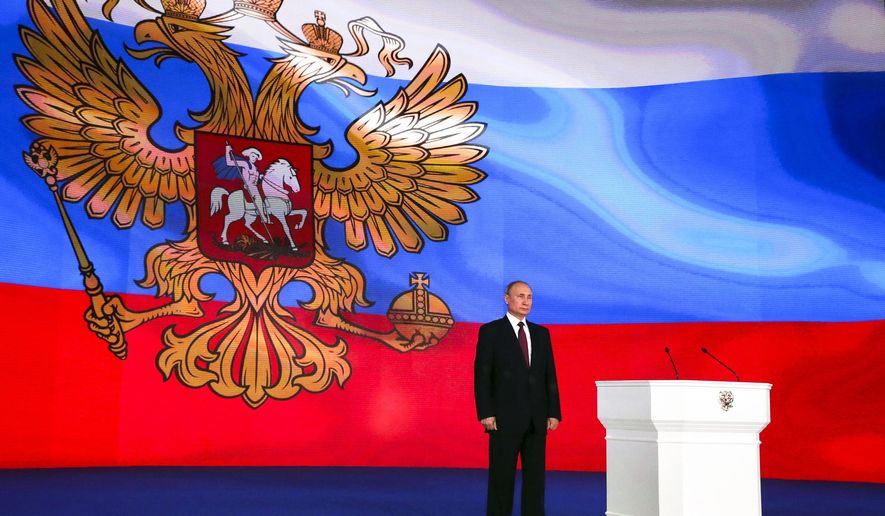WASHINGTON (AP) - The Trump administration told Congress on Thursday that it plans to sell Ukraine 210 anti-tank missiles to help it defend its territory from Russia, in a major escalation of U.S. lethal assistance to Ukraine’s military.
The long-awaited move, which lawmakers of both parties have been urging for years, deepens America’s involvement in the military conflict and may further strain relations with Moscow. It came the same day that Russian President Vladimir Putin announced his country has developed new nuclear weapons he claims can’t be intercepted by an enemy.
The $47 billion sale includes the 210 American-made Javelin missiles along with 37 command launch units. In anticipation of the sale, the United States has already started training Ukraine’s forces on how to use them. The missiles will come from existing U.S. Army stockpiles, probably those that are already stationed in Europe, speeding up the process for transferring them to Ukraine’s military.
Ukraine has long sought to boost its defenses against Russian-backed separatists armed with tanks that have rolled through eastern Ukraine during violence that has killed more than 10,000 since 2014. Previously, the U.S. has provided Ukraine with support equipment and training, and has let private companies sell some small arms like rifles.
The White House initially approved a plan to sell the missiles to Ukraine in December, but no weapons have been delivered because the administration hadn’t completed the formal process. Following the administration’s written notification to Congress on Thursday, lawmakers now have a 30-day window to block the sale if they disapprove. But the top Republican and Democrat on the foreign relations panels in the House and Senate have informally given the green light, so the sale is expected to go through without any significant hurdles.
That means the weapons will probably be delivered to Ukraine around mid-April, said several congressional officials, who weren’t authorized to discuss the plan publicly and requested anonymity.
“Ukraine will have no difficulty absorbing this system into its armed forces,” the Defense Security Cooperation Agency, part of the U.S. military, said in a statement.
The move is likely to become another sore point between Washington and Moscow, as President Donald Trump contends with questions about whether he’s too hesitant to confront the Kremlin. Ukraine accuses Russia of sending the tanks, and the U.S. says Moscow is arming, training and fighting alongside the separatists.
Heightened U.S.-Russia tensions were on display earlier Thursday in Putin’s speech, when he showed videos and computer simulations and declared that Russia’s newly developed weapons would render NATO’s missile defense systems “useless.” In a message clearly directed at the United States, Putin said: “You have failed to contain Russia.”
State Department spokeswoman Heather Nauert said the U.S. had watched Putin’s speech “with great interest.”
“It was certainly unfortunate to have watched the video animation that depicted a nuclear attack on the United States,” Nauert said. “We don’t regard that as the behavior of a responsible international player.”
Although the portable anti-tank missiles being sold to Ukraine can kill, proponents for granting them have long argued they are considered “defensive” because the Ukrainians would use them to defend their territory and deter the Russians, not to attack a foreign country or seize new territory.
Trump had been considering the plan for some time after the State Department and the Pentagon signed off earlier this year. President Barack Obama also considered sending lethal weapons to Ukraine, but left office without doing so.
The move comes as the United States and European nations struggle to break a long logjam in the Ukraine-Russia conflict that erupted three years ago when fighting broke out between Russian-backed separatists and government troops in the east. France, Russia and Germany brokered a peace arrangement in 2015 that has lowered violence but not stopped it, and a political settlement outlined in the deal hasn’t been fully implemented.
Both the Obama and Trump administrations had expressed concerns in the past that injecting more weapons into the conflict was unlikely to resolve it, especially considering that Russia is well-equipped to respond to any Ukrainian escalation with an even stronger escalation of its own. Sending lethal weapons to Ukraine also creates the troubling possibility that American arms could kill Russian soldiers, a situation that could thrust the two nuclear-armed nations closer to direct confrontation.
The United States, under Obama, also imposed sanctions on Russia for its invasion and annexation of Crimea. The Trump administration has insisted those sanctions will stay in place until Moscow gives up the Crimean Peninsula.
___
Reach Josh Lederman on Twitter at http://twitter.com/joshledermanAP




Please read our comment policy before commenting.